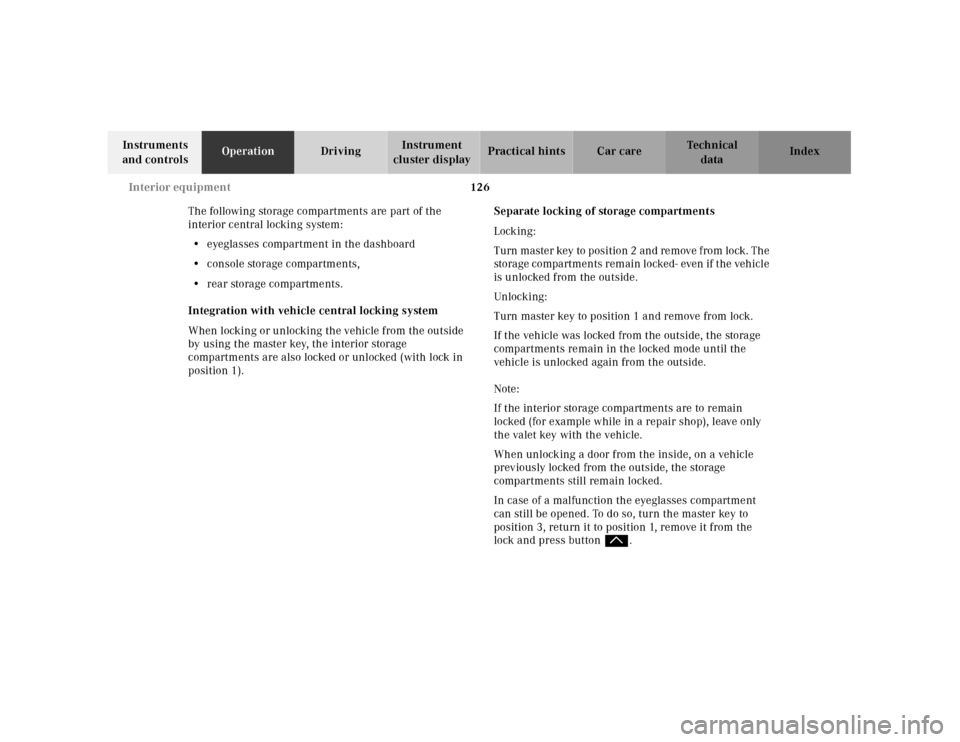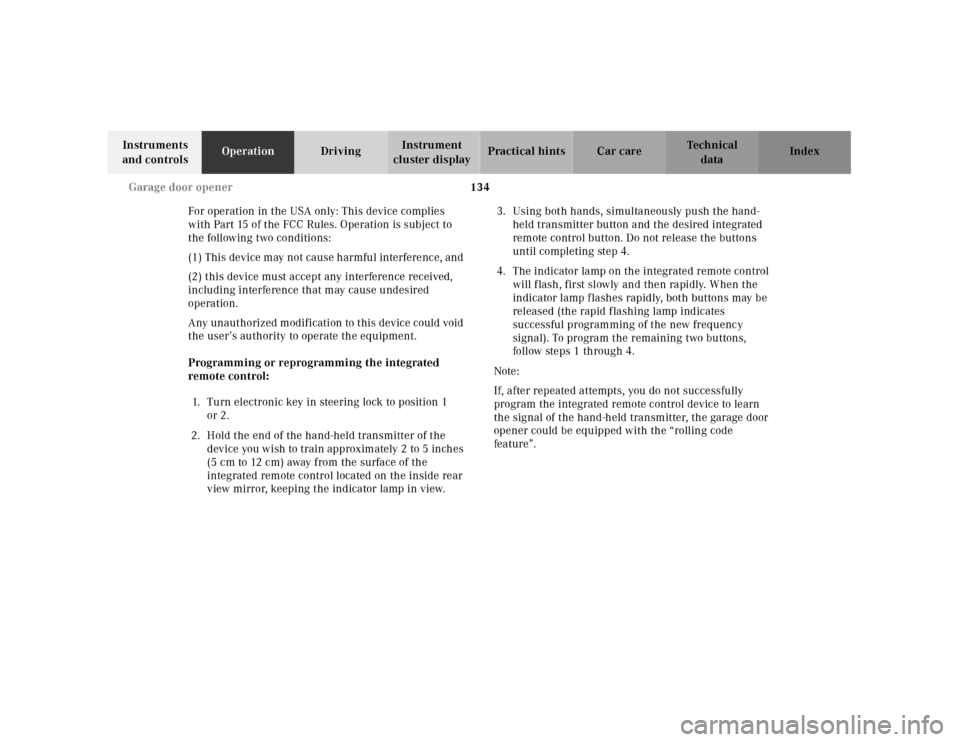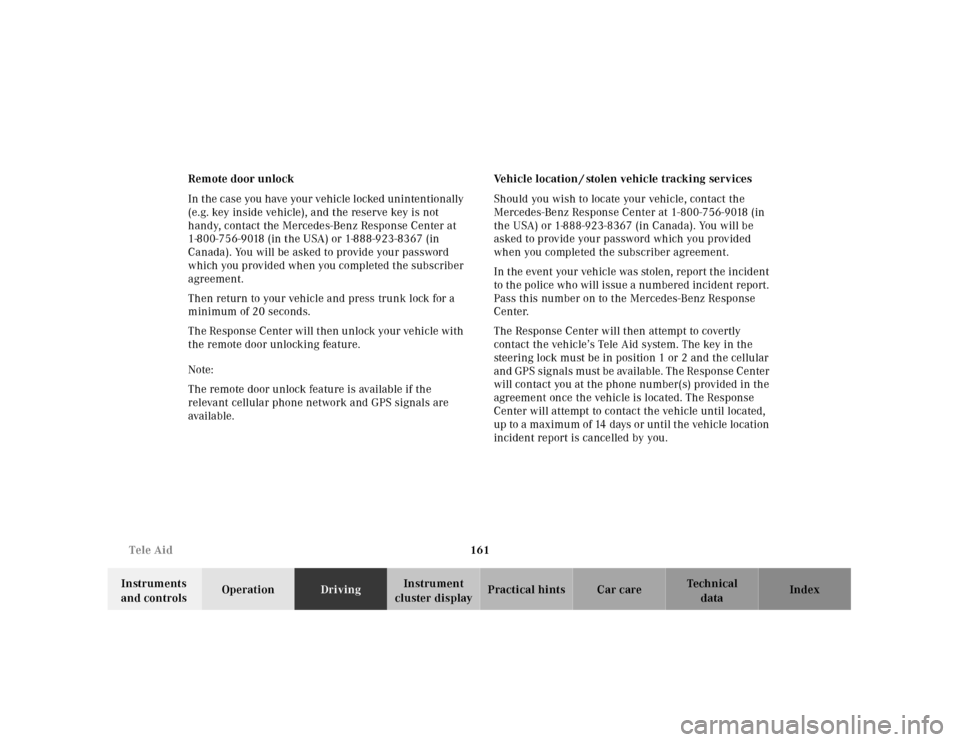Page 130 of 297

126 Interior equipment
Technical
data Instruments
and controlsOperationDrivingInstrument
cluster displayPractical hints Car care Index
The following storage compartments are part of the
interior central locking system:
• eyeglasses compartment in the dashboard
• console storage compartments,
• rear storage compartments.
Integration with vehicle central locking system
When locking or unlocking the vehicle from the outside
by using the master key, the interior storage
compartments are also locked or unlocked (with lock in
position 1).Separate locking of storage compartments
Locking:
Turn master key to position 2 and remove from lock. The
storage compartments remain locked- even if the vehicle
is unlocked from the outside.
Unlocking :
Turn master key to position 1 and remove from lock.
If the vehicle was locked from the outside, the storage
compartments remain in the locked mode until the
vehicle is unlocked again from the outside.
Note:
If the interior storage compartments are to remain
locked (for example while in a repair shop), leave only
the valet key with the vehicle.
When unlocking a door from the inside, on a vehicle
previously locked from the outside, the storage
compartments still remain locked.
In case of a malfunction the eyeglasses compartment
can still be opened. To do so, turn the master key to
position 3, return it to position 1, remove it from the
lock and press button p.
Page 138 of 297

134 Garage door opener
Technical
data Instruments
and controlsOperationDrivingInstrument
cluster displayPractical hints Car care Index
For operation in the USA only: This device complies
with Part 15 of the FCC Rules. Operation is subject to
the following two conditions:
(1) This device may not cause harmful interference, and
(2) this device must accept any interference received,
including interference that may cause undesired
operation.
Any unauthorized modification to this device could void
the user’s authority to operate the equipment.
Programming or reprogramming the integrated
remote control:
1. Turn electronic key in steering lock to position 1
or 2.
2. Hold the end of the hand-held transmitter of the
d evice you w ish to train approxim ately 2 to 5 inch es
(5 cm to 12 cm) away from the surface of the
integrated remote control located on the inside rear
view mirror, keeping the indicator lamp in view.3. Using both hands, simultaneously push the hand-
held transmitter button and the desired integrated
remote control button. Do not release the buttons
until completing step 4.
4. The indicator lamp on the integrated remote control
will flash, first slowly and then rapidly. When the
indicator lamp f lashes rapidly, both buttons may be
released (the rapid flashing lamp indicates
successful programming of the new frequency
signal). To program the remaining two buttons,
follow ste ps 1 through 4.
Note:
If, after repeated attempts, you do not successfully
program the integrated remote control device to learn
the signal of the hand-held transmitter, the garage door
opener could be equipped with the “rolling code
feature”.
Page 140 of 297
136 Garage door opener
Technical
data Instruments
and controlsOperationDrivingInstrument
cluster displayPractical hints Car care Index
Operation of remote control:
1. Turn electronic key in steering lock to position 1
or 2.
2. Select and press the appropriate button to activate
the remote controlled device. The integrated remote
control transmitter continues to send the signal as
long as the button is pressed – up to 20 seconds.Erasing the remote control memory:
1. Turn electronic key in steering lock to position 1
or 2.
2. Simultaneously holding down the left and right side
buttons for approximately 20 seconds, or until the
control la mp blink ra pidly, will erase th e codes of all
three channels.
Page 141 of 297
137 Hardtop
Technical
data Instruments
and controlsOperationDrivingInstrument
cluster displayPractical hints Car care Index Hardtop or
panorama roof (optional)
The removal or attachment of the hardtop can be carried
out by 2 persons.Removing hardtop
1. Engage parking brake.
2. Open doors.
3. Disconnect plug (1) for rear window defroster.
Wa r n i n g !
Do not place your hands between the hardtop and
the car body while the hardtop is being locked or
unlocked. Serious personal injury may occur.
1
P65.00-0281-26
Page 144 of 297
140 Hardtop
Technical
data Instruments
and controlsOperationDrivingInstrument
cluster displayPractical hints Car care Index
Attaching hardtop
1. Engage parking brake and turn key in steering lock
to position 2.
2. Lower roll bar, see page 118.
3. Open doors.
4. Turn radio and telephone off to lower power
antenna, turn key in steering lock to position 0 and
remove.5. From the rear of the vehicle, lift the hardtop
c a r e f u l ly ove r t h e a t ta ch m e n t p oi n t s ( 1 ) a nd l oc a t in g
points (2). First guide the rear pins of the top
vertically into the rear attachment points, then
lower the roof onto the vehicle and locate the front
locking pins. Exercise caution when maneuvering
the top. To avoid paint damage, the top’s mounting
pins must not be allowed to contact the body.
Page 165 of 297

161 Tele Aid
Technical
data Instruments
and controlsOperationDrivingInstrument
cluster displayPractical hints Car care Index Remote door unlock
In t he c ase you have your vehicle locked unintentionally
(e.g. key inside vehicle), and the reserve key is not
handy, contact the Mercedes-Benz Response Center at
1-800-756-9018 (in the USA) or 1-888-923-8367 (in
Canada). You will be asked to provide your password
which you provided when you completed the subscriber
agreement.
Then return to your vehicle and press trunk lock for a
minimum of 20 seconds.
The Response Center will then unlock your vehicle with
the remote door unlocking feature.
Note:
The remote door unlock feature is available if the
relevant cellular phone network and GPS signals are
available.Vehicle location / stolen vehicle tracking services
Should you wish to locate your vehicle, contact the
Mercedes-Benz Response Center at 1-800-756-9018 (in
the USA) or 1-888-923-8367 (in Canada). You will be
asked to provide your password which you provided
when you completed the subscriber agreement.
In the event your vehicle was stolen, report the incident
to th e police wh o will issu e a nu mbered incident report.
Pass this number on to the Mercedes-Benz Response
Center.
The Response Center will then attempt to covertly
contact the vehicle’s Tele Aid system. The key in the
steering lock must be in position 1 or 2 and the cellular
and GPS signals must be available. The Response Center
will contact you at the phone number(s) provided in the
agreement once the vehicle is located. The Response
Center will attempt to contact the vehicle until located,
up to a maximu m of 14 days or until t he vehicle location
incident report is cancelled by you.
Page 170 of 297
166 Steering lock
Technical
data Instruments
and controlsOperationDrivingInstrument
cluster displayPractical hints Car care Index
Notes:
A warning sounds when the driver’s door is opened
while the key is in steering lock position 1 or 0.
With the engine at idle speed, the charging rate of the
alternator (output) is limited.
It is therefore recommended that you turn off
unnecessary electrical consumers while driving in stop-
and-go traffic. This precaution helps to avoid draining of
the battery.
Unnecessary strain on the battery and charging system
may be minimized by turning off the following power
consumers, for example: Heated seats, rear window
defroster.Caution!
To prevent accelerated battery discharge and a possible
dead battery, always remove the key from the steering
lock. Do not leave the key in steering lock position 0.
Page 241 of 297
237 Battery
Technical
data Instruments
and controlsOperation DrivingInstrument
cluster displayPractical hintsCar care Index Do not close a door with the windows fully closed while
the power supply is interrupted (battery disconnected or
empty).
Doing so could damage the window frame.
Note:
After reconnecting the battery also set the clock,
resynchronize the express feature of the power
windows, the electronic stability program (ESP) and the
adaptive damping System (ADS).
See page 79 for setting clock, page 41 for power
windows, page 193 for ESP and page 199 for ADS. Battery Recycling
Batteries contain materials that can harm the
environment with improper disposal.
Large 12 Volt storage batteries contain lead.
Recycling of batteries is the preferred method of
disposal.
Many states require sellers of batteries to accept old
batteries for recycling.